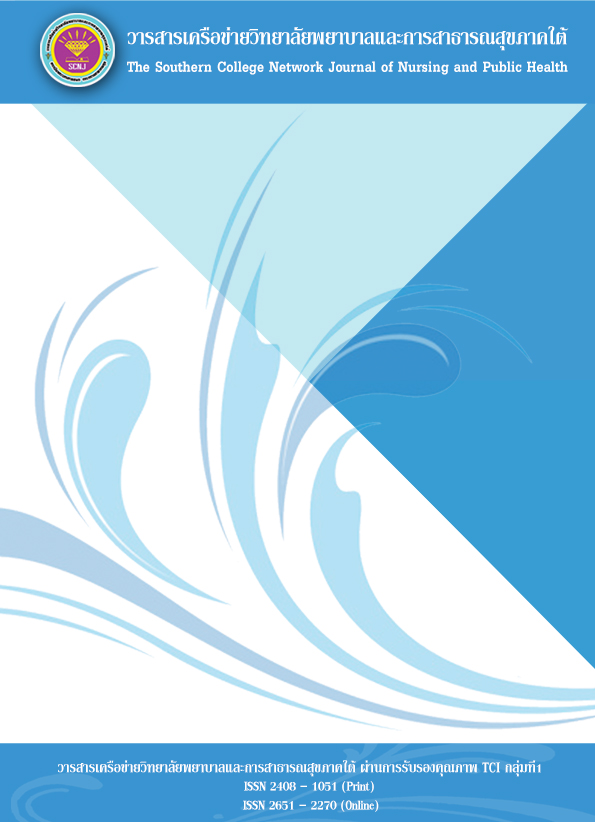ความชุกและปัจจัยที่มีความสัมพันธ์ต่อความเสี่ยงข้อเข่าเสื่อม ในผู้สูงอายุอำเภอป่าพะยอม จังหวัดพัทลุง
คำสำคัญ:
ความชุก, โรคข้อเข่าเสื่อม, ผู้สูงอายุ, ความเสี่ยงบทคัดย่อ
การศึกษาเชิงวิเคราะห์ภาคตัดขวางครั้งนี้มีวัตถุประสงค์เพื่อศึกษาความชุก และปัจจัยที่มีความสัมพันธ์ต่อความเสี่ยงข้อเข่าเสื่อมในผู้สูงอายุ อำเภอป่าพะยอม จังหวัดพัทลุง กลุ่มตัวอย่างคือผู้สูงอายุที่มีอายุ 60 ปี ขึ้นไปที่ขึ้นทะเบียนในโรงพยาบาลส่งเสริมสุขภาพตำบล ทำการสุ่มอย่างง่ายจำนวน 2 ตำบลจากทั้งหมด 4 ตำบล ได้แก่ ตำบลลานข่อยและตำบลบ้านพร้าวทำการศึกษาผู้สูงอายุทุกคนที่อาศัยในทั้ง 2 ตำบล ระหว่างเดือนมีนาคม ถึง เมษายน พ.ศ. 2561 ได้กลุ่มตัวอย่างทั้งหมดจำนวน 1,692 คน เครื่องมือเก็บข้อมูลประกอบด้วย 1) ข้อมูลคุณลักษณะประชากร 2) แบบสัมภาษณ์พฤติกรรมการดูแลตนเอง และ 3) แบบคัดกรองโรคข้อเข่าเสื่อม วิเคราะห์ข้อมูลเบื้องต้นด้วยสถิติเชิงพรรณนา และวิเคราะห์ปัจจัยที่มีความสัมพันธ์ต่อความเสี่ยงข้อเข่าเสื่อมด้วยสถิติถดถอยพหุคูณโลจิสติก ผลการวิจัยพบว่า
1. ความชุกของความเสี่ยงข้อเข่าเสื่อมในผู้สูงอายุเท่ากับร้อยละ 57.33
2. ปัจจัยด้านเพศ ดัชนีมวลกาย ระดับการศึกษา และการมีโรคประจำตัวมีความสัมพันธ์ต่อความเสี่ยงข้อเข่าเสื่อมในผู้สูงอายุอย่างมีนัยสำคัญทางสถิติ โดยที่เพศหญิงมีความเสี่ยงข้อเข่าเสื่อม 1.44 เท่า (ORadj = 1.44, 95%CI; 1.17-1.77) ส่วนผู้ที่มีดัชนีมวลกายระดับท้วมและระดับอ้วนมีความเสี่ยงข้อเข่าเสื่อม 1.52 เท่า (ORadj = 1.52, 95%CI: 1.14-2.02) และ 1.58 เท่า (ORadj = 1.58, 95%CI: 1.22-2.05) ตามลำดับ สำหรับผู้ที่มีระดับการศึกษาชั้นประถมศึกษามีความเสี่ยงข้อเข่าเสื่อม 1.39 เท่า (ORadj = 1.39, 95%CI: 1.11-1.73) นอกจากนี้ พบว่าผู้ที่มีโรคประจำตัวมีความเสี่ยงข้อเข่าเสื่อม 1.87 เท่า (ORadj = 1.87, 95%CI: 1.52-2.29)
บุคลากรสาธารณสุขควรส่งเสริมและจัดกิจกรรมการออกกำลังกายเพื่อลดดัชนีมวลกาย โดยเฉพาะการดูแลผู้สูงอายุเพศหญิงที่มีดัชนีมวลกายเกินเกณฑ์มาตรฐานควรได้รับการดูแลเป็นพิเศษ เพื่อป้องกันความเสี่ยงของการเกิดโรคข้อเข่าเสื่อมในผู้สูงอายุ ต่อไป
เอกสารอ้างอิง
Bureau of Policy and Strategy, Ministry of Public Health. (2016). Public Health Statistic A. D. 2015. Bangkok: Samcharounpanit. (in Thai)
Chiraviboonwan, P. (2017). Osteoarthritis is Really Osteoarthritis. Journal of Department of Medical Services, 42(3), 29-33. (in Thai)
Cohen, J. (1988). Statistical Power Analysis for the Behavioral Sciences. (2nd ed.). New Jersey: Lawrence Erlbaum Associates Publishers.
Department of Medical Services, Ministry of Public Health. (2015) Guide for Screening/ Evaluating the Elderly. Bangkok: The War Veterans Organization. (in Thai)
Hsieh, F. Y., Bloch, D. A., & Larson, M. D. (1998). A Simple Method of Sample Size Calculation for Linear and Logistic Regression. Statistics in Medicine, 17(14), 1623-1634.
Khongtong, P. (2017). Ability in Daily Living and the Severity of Osteoarthritis of the Knee of the Elderly : Don Chang Health Promotion Hospital, Muang District, Khon Kaen Province. Journal of Humanities and Social Sciences, 9(18), 120-128. (in Thai)
Kim, S. (2008). Changes in Surgical Loads and Economic Burden of Hip and Knee Replacements in the US : 1997–2004. Arthritis Rheum, 59(4), 481-488.
Koedwan, C., Bun in, J., Teerasombut, C., & Kuptniratsaikul, V., (2016). The Prevalence of Knee OA in Community-Based Elders. Thai journal of Physical Therapy, 38(2), 59-70. (in Thai)
Ministry of Public Health. (2018). Health Data Center: HDC. Retrieved January 31, 2018 from https://hdcservice.moph.go.th. (in Thai)
Nakaseni, S. (2018). Self-Healthcare Behavior of The Elderly in Bangkok. Journal of Rambhai Barni Research Journal, 12(1), 39-48. (in Thai)
Nimit-Arnun, N. (2014). The Epidemiological Situation and Risk Assessment of Knee Osteoarthritis among Thai People. Journal of The Royal Thai Army Nurses, 15(3), 185-194. (in Thai)
Pender, N. J. (19870). Health Promotion in Nursing Practice. (2nd ed.). Connecticut: Appleton & Lange.
Pereira, D., Peleteiro, B., Araújo, J., Branco, J., Santos, R. A., & Ramos, E. (2011). The Effects of Osteoarthritis Definition on Prevalence and Incidence Estimates: a Systematic Review. Osteoarthritis and Cartilage, 19(11), 1270-1285.
Phermpool, P. (2010). Severity of Osteoarthritis and Self - Care Behavior of Patients with Osteoarthritis of the Knee in Siriraj Hospital. A Thesis Submitted in Partial Fulfillment of the Requirement for the Master of Science Degree. Department of Science Society and Management of Health Systems, Silpakorn University. (in Thai)
Royal Orthopedic Medical College of Thailand. (2011). Osteoarthritis Public Health Service Guidelines. Retrieved July 15, 2019 form www.rcost.or.th. (in Thai)
Saraboo, Y. (2014). Symptoms, Knowledge, and Perceived Illness Representation Related to Knee Osteoarthritis among Elderly in a Community: a Pilot Study. Journal of Boromarajonani College of Nursing, Bangkok, 30(2), 12-24. (in Thai)
Shane Anderson, A., & Loeser, R. F. (2010). Why is Osteoarthritis an Age-Related Disease?. Best Pract Res Clin Rheumatol, 24(1), 15-26.
Singha, S., Durongritthichai, W., Surapan, J., Kasipol, T., & Khlangthumnueam, K. (2015). Factors Affecting to Self-Care Behavior of the Elderly with Knee Osteoarthritis in Praksa Municipality Area, Muang District, Samutprakarn Province. HCU Journal, 18(36), 115-130. (in Thai)
World Health Organization. (2003). The Burden of Musculoskeletal Conditions as the Start Millennium. Report of a WHO Scientific Group.
ดาวน์โหลด
เผยแพร่แล้ว
ฉบับ
ประเภทบทความ
สัญญาอนุญาต
1. บทความหรือข้อคิดเห็นใด ๆ ที่ปรากฏในวารสารเครือข่าย วิทยาลัยพยาบาลและการสาธารณสุขภาคใต้ ที่เป็นวรรณกรรมของผู้เขียน บรรณาธิการหรือเครือข่ายวิทยาลัยพยาบาลและวิทยาลัยการสาธารณสุขภาคใต้ ไม่จำเป็นต้องเห็นด้วย
2. บทความที่ได้รับการตีพิมพ์ถือเป็นลิขสิทธิ์ของ วารสารเครือข่ายวิทยาลัยพยาบาลและการสาธารณสุขภาคใต้








